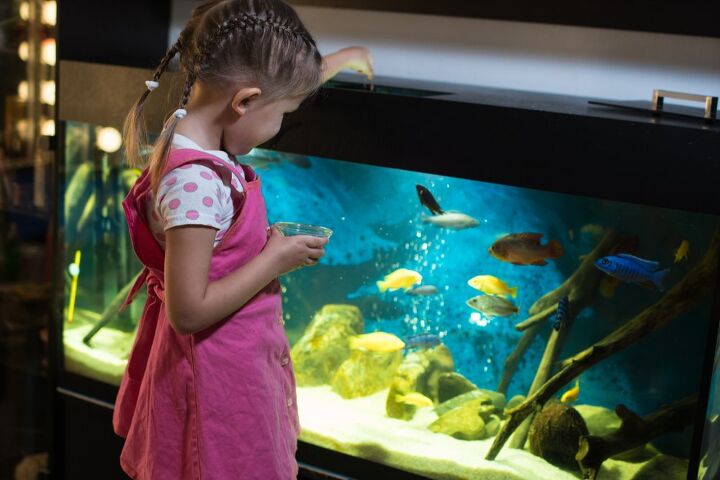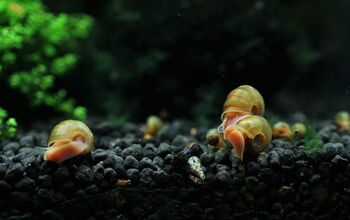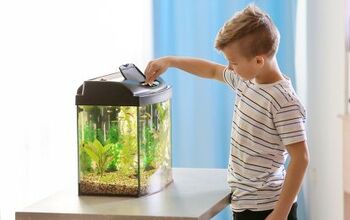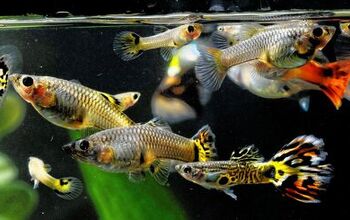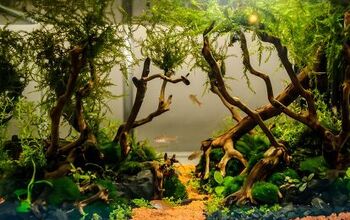Why Are None Of My Pet Fish Eating?

Fish tanks are equally rewarding and stressful, and that’s because things can quickly go wrong. Everything from the pH level and color of the water to the eating habits of the fish can make anyone go into crisis mode. So, why are none of my pet fish eating?
Check the pH level in your tank if none of your fish are eating, and make sure it’s between 6.8 and 7.8. Your fish may not eat if the water has too much nitrate and the water is murky. In that case, you must replace 10% to 25% of the water in the tank to keep the fish healthy.
You may also simply need to buy a different type of food if your fish won’t eat it. Look into the dietary needs of each fish in your tank, as it varies between species. Follow along as we explore why your pet fish won’t eat and highlight ways to increase their appetites.
Why Won’t My Fish Eat?
If your fish won’t eat, it’s likely because of the food source or quality of the water. That said, this can be a complicated issue, so you must closely monitor the fish in your tank. Luckily, there are a few common problems that may make your fish stop eating, and they are easy to resolve.
1. Your Fish Are Stressed
Much like people, your pet fish can get stressed. Everything from poor water quality and over-stimulation to a change in food can stress out your fish. Fish may abstain from food or simply eat less than usual when they become stressed.
You can tell that your fish are stressed and even sick if they move around erratically and refuse to eat. Their gills may also flap more than usual, and they may swim in patterns you don’t typically see. Pay attention to your fish so you can reduce and remove stress factors that affect their behavior.
2. Poor Water Quality
The quality of the water in your fish tank is more important than anything else. Fish are quite sensitive to chemicals, temperature, bacteria, and fungi, among other factors. The temperature of the water in your tank doesn’t just affect their comfort, it affects their health.
It’s important to test your fish tank’s pH level 1-2 times per month, or as needed if you notice your fish won’t eat. Your fish tank can also quickly become unhealthy if you don’t change the water enough. Ideally, you should change the water in your fish tank once every 2 weeks, or sooner if it becomes murky.
How long you can go without changing the water ultimately depends on the volume of your tank and the plants and fish within it. You can tell it’s time to change the water if it’s cloudy and discolored, and if the fish rush to get air near the surface. Change between 10% to 25% of the water to maximize oxygen and remove waste.
3. The Wrong Food
The food that you use to feed your fish will ultimately determine their health and quality of life. Research the best food for your fish based on its species, as there is no universal fish food. Reef fish and freshwater fish differ significantly when it comes to their dietary needs and restrictions.
For example, pellet food is ideal for coral and reef fish because it typically provides the best nutrient balance. Freshwater fish love live food, such as worms, plankton, insects, and prawns. This can be tricky if you have a tank that contains several types of fish from different regions.
Ideally, you should dedicate a single tank to fish that have the same dietary requirements. Otherwise, there is no way to guarantee your fish will get the nutrients they need to thrive.
4. Health Problems
Your fish may be suffering health problems if none of them eat. Fish in tanks are prone to parasites and bacterial infections that can quickly cause their health to deteriorate. The best way to protect your fish from disease is to change the water at least twice a month.
You must also maintain a pH level between 6.8 and 7.8 to minimize the risk of disease and infections. A pH level of 8 is typically safe, but anything higher than that is risky. Buy some pH strips from your local pet store to monitor the quality of the water in your fish tank.
It’s also important to control the algae within your fish tank to protect your fish. Watch out for blue-green algae, as that can be particularly harmful to your fish. The algae can contaminate the water, harm your fish, and cause them to stop eating.
5. Overfeeding
It’s all too easy to feed your pet fish too much food. Too much of a good thing can be quite harmful, so you must be careful when you feed your fish. You only typically need to feed your fish once or twice a day for them to get their daily nutrients.
Overfeeding your fish can affect their metabolism, digestion, and weight. This may make them eat less because they’re still digesting food from earlier. They may ignore the food you put in the tank, and it will sink to the bottom.
Not only does this waste the food, but it can contaminate the water. The food may eventually rot, taint the water, and affect the health of your fish.
6. Lack Of Stimulation
Just like us, fish require stimulation to function in their daily lives. You can stimulate your fish with vibrant colors and plants that give them something to do. The more stagnant your fish are, the less healthy they will be.
You can also put floating toys in your fish tank to stimulate your fish. It also helps to put caves in your tank so your fish can swim around obstacles. This will help stimulate their brains and increase their appetite.
A plain tank with no plants, rocks, and toys doesn’t provide nearly enough stimulation for fish. Even something as simple as ping pong balls can entertain and enrich your fish.
Should I Remove Uneaten Fish Food?
Remove uneaten fish food from your tank to avoid nitrate problems. The uneaten food can also contaminate the water. Ideally, you should remove uneaten food from the bottom of your tank if your fish haven’t eaten it within 10 minutes. Otherwise, you may throw off the chemical balance within the water.
Does Fish Food Go Bad?
Fish food can go bad in as little as 6 months. Many common fish food products have a 6-month expiration date. That said, it’s important to read the label, because it can go bad much sooner.
It ultimately depends on when the food was packaged and when you bought it. The average fish owner goes through fish food quickly, especially if you have many fish in your tank.
Summing It Up
Change 10% to 25% of the water in your tank if none of your fish will eat. Your fish also won’t eat if the pH level is wrong and if they have bacterial infections. Carefully research the best food for your fish based on their species and dietary restrictions. Otherwise, your fish may not be interested enough to eat the food in your tank, and they will suffer from malnutrition.
Related Guides:

Nick Durante is a professional writer with a primary focus on home improvement. When he is not writing about home improvement or taking on projects around the house, he likes to read and create art. He is always looking towards the newest trends in home improvement.
More by Nick Durante



